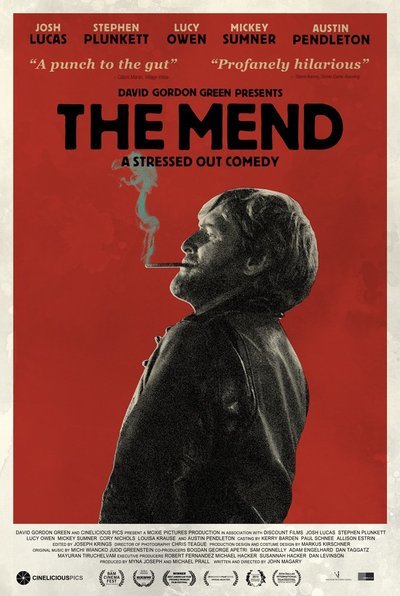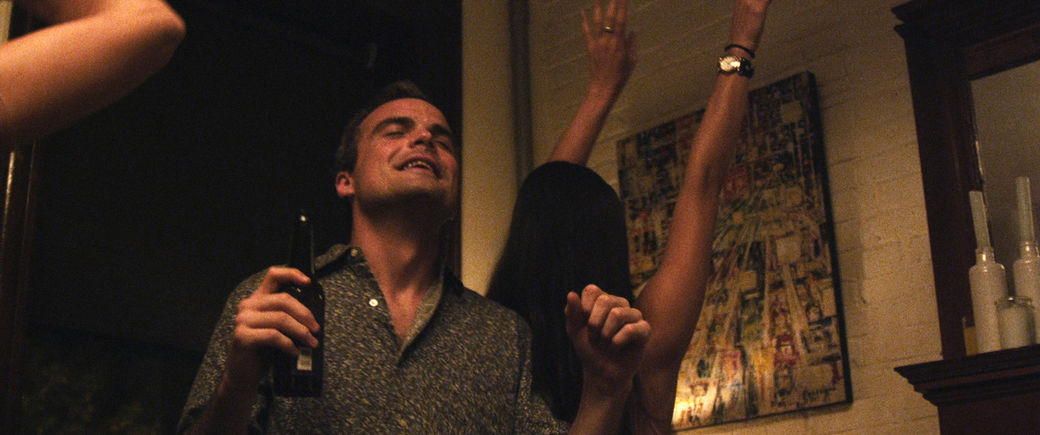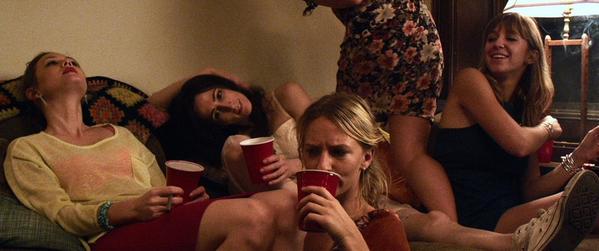Director: John Magary
Genre: Drama, Comedy
Release: 2014
If you were to spot a summary for writer-director John Magary’s first feature film in a festival catalogue, it would likely strike you as the kind of Sundance-darling American indie that would give you the urge to run for the hills. Take the iTunes synopsis for example: “THE MEND follows a mis-matched yin-yang pair of NYC brothers as they stagger dimly towards some understanding of love, women, masculinity and what it means to truly be a brother.” This synopsis could not be farther from the film itself, but that being said, any synopsis of this film is likely to sell it short. The reason for the futility inherent in attempting to summarize THE MEND is that Magary is all about defying tidy understandings of people, and subverting the packaged narratives that you might expect to logically flow given the archetypes that the characters initially seem to embody.
Josh Lucas, somehow making vaping even sadder
Within the first half hour of THE MEND, Mat (Josh Lucas) commits an unseen wrongdoing during foreplay with his girlfriend, Andrea (Lucy Owen), acts callously toward a woman that he once agreed to conduct a business venture with, and has an adulterous one night stand with a girl he just met at a party. However, as Dan Sallitt explains, “the ostensible subject of a bad guy wreaking havoc (is) quickly dissolved into an entropic mist.”1 Rather than emphasizing the bad-boy trope for knowing yucks, Magary shows Mat to be a complex individual, given to surprising moments of tenderness. Similarly, Mat’s brother, Alan (Stephen Plunkett), initially comes off as a self-satisfied elitist who responds childishly when his girlfriend Farrah (Mickey Sumner) doesn’t acknowledge his cleverness. When he returns by himself from a trip with Farrah that was supposed to end with his engagement, Alan acts with surprising generosity to the brother who has shacked up in his apartment, and even welcomes Andrea and her son to join them. Rather than haughtily lashing out at others during his time of depression, Alan transitions into a state of melancholic liberation. Nowhere is this more evident than when he feigns interest in Andrea’s risibly masculine ex-husband and covertly riffs on the mundanity of the ex’s job as a CPA. The smug elements in Alan’s persona are still there, but they’re combined with a pleasing flair for anarchic wittiness that wasn’t apparent during the party sequence.
The two unbuttoned buttons indicate Stephen Plunkett knows how to party
Aside from his knack for characterization, what distinguishes Magary from your average Sundance director in terms of form has a lot to do with his editing rhythms which, as Peter Labuza discusses in an episode of The Cinephiliacs, change with each new scene to adapt to the diverging tones that Magary is playing against each other.2 This varied approach to form gives you the sense of the filmmakers trying to keep pace with the erratic emotional terrain that the actors are taking the film to. A few of the reviews I have read for this film compare Magary to Arnaud Desplechin, and one can note this in The Mend‘s manic energy, push-ins that build a sense of (often soon-to-be-thwarted) anticipation, and an overwhelming amount of detail accumulated from scene to scene. I wouldn’t stress the Desplechin connection too much, but if you didn’t already know Magary was a cinephile, it becomes evident through his rich array of influences: the track-zooms and music cues of Martin Scorsese, the effete performance style of Whit Stillman, a nighttime sojourn that recalls Mike Leigh’s NAKED. I want to focus specifically on Francois Truffaut and JULES AND JIM, not because Magary explicitly apes Truffaut, but rather because THE MEND’s tonal shifts bring Truffaut to mind in a way that sheds light on Magary’s approach to structure.
Have you ever seen a more striking cinematic depiction of red Solo cups?
Both JULES AND JIM and THE MEND begin with flurries of performative ebullience, while also introducing underlying sources of discord that both directors allow to swim under the surface for the remainder of their films. THE MEND starts with a thirty minute party scene that deftly weaves from conversation to conversation, momentarily dropping one thread to pick up a few others before returning to the original. Magary’s editing scheme and inclusiveness bring about a joyful sense of spontaneity, which Magary contrasts with the icy repartee that Alan and his girlfriend exhibit. Following the party sequence, traces of dysfunction stemming from Alan’s depression and Mat’s impulsive behavior start to seep into the rest of a film, as the brothers attempt to maintain order in an unstable living arrangement. One way Magary conveys this structurally is through ellipses, the most notable of which arrives after a great scene by the Hudson River in which Alan reveals to Andrea what took place during his vacation. Rather than allowing the audience to learn exactly what happened between Alan and Farrah, Magary restricts the audience’s POV to a shot from Mat’s removed perspective until Alan is in tears and the actual revelation has passed. Not long after this scene ends, Andrea once scolds Mat for an unspecified transgression and announces that she’ll be living separately from him.
If you’ve ever been unable to access a bathroom in your own home, THE MEND has a scene for you!
Magary withholds information from the audience in order to emphasize the limitations in our perspective and suggest the tumult that the characters are trying to keep at bay. Similar to Truffaut, Magary employs structural tropes such as ellipses and editing schemes that compress time to convey a sense of dissonance that builds until the film’s climax. Another tactic Magary employs is the introduction of scenes that don’t fit cleanly within the film’s narrative progression. One such disparate scene occurs when Alan returns to his legal aid office despite being on vacation and sits in as a colleague talks to a Latino man with financial problems who confesses to performing oral sex for money. Despite my enjoyment of this scene, I’m still not entirely sure what it accomplishes in the context of the film. It at once suggests a limitation in our viewpoint within the broader world of New York City (we’re restricted to a primarily white, middle class milieu) and displays Alan’s eccentric behavior in his attempts to relate with the man by telling a tangentially related story.
No matter what understanding I try to arrive at regarding the placement of any scene within this film, I keep coming back to the word entropy, which Dan Sallitt emphasizes in his screening notes – this idea of behavior being shaped by random factors including external occurrences like helicopter noises, power outages, and especially the physical space that the characters inhabit within the apartment. Magary has a talent for observing people as they interact with their surroundings and conveying the tensions of living in a shared space. No scene better testifies to this than the film’s climax, which turns what appears to be a throwaway scene of the hungover brothers recovering from a wild night into a meticulously sequenced set-piece that lays bare the buried frictions of their relationship. So to return to our lovely iTunes synopsis, does this scene lead to the brothers gaining an “understanding of love, women, masculinity, and what it means to truly be a brother?” Not at all, and I’m still trying to parse what the ending does leave me with aside from the feeling of elation I had upon leaving the theater following two screenings. What I am sure of is that John Magary is the most exciting new talent in independent cinema and that THE MEND is the best American debut feature film in quite some time.
THE MEND is available to stream on Amazon, Video-on-Demand, iTunes, and VUDU.
Verdict: Recommend
- Sallitt, Dan, Screening Notes for The Mend,
https://twitter.com/sallitt/status/638188489201352704
- Labuza, Peter, The Cinephiliacs: Episode 65, “3:18-8:04 Establishing Shots – The
Mend”, http://www.thecinephiliacs.net/2015/08/episode-65-jim-healy-mind-reader.html





